Maruti Suzuki: Micro and Macro Environment Strategic Analysis Report
VerifiedAdded on 2023/01/09
|13
|3944
|41
Report
AI Summary
This strategic report provides an in-depth analysis of Maruti Suzuki, an automobile manufacturing company in India. It begins with an executive summary, followed by an introduction to Maruti Suzuki and its operations. The report then delves into the micro and macro environmental factors influencing Maruti Suzuki, identifying key opportunities such as increasing demand for SUVs and threats like intense competition and the shift towards electric vehicles. A detailed evaluation of Maruti Suzuki's resources highlights its distinctive capabilities, particularly its dealer integration and strong market position. The report concludes with recommendations for Maruti Suzuki's international expansion, suggesting a phased approach starting with exporting and later establishing a subsidiary in the Netherlands. The report also provides an overview of Maruti Suzuki's strategic vision, values, and service offerings.
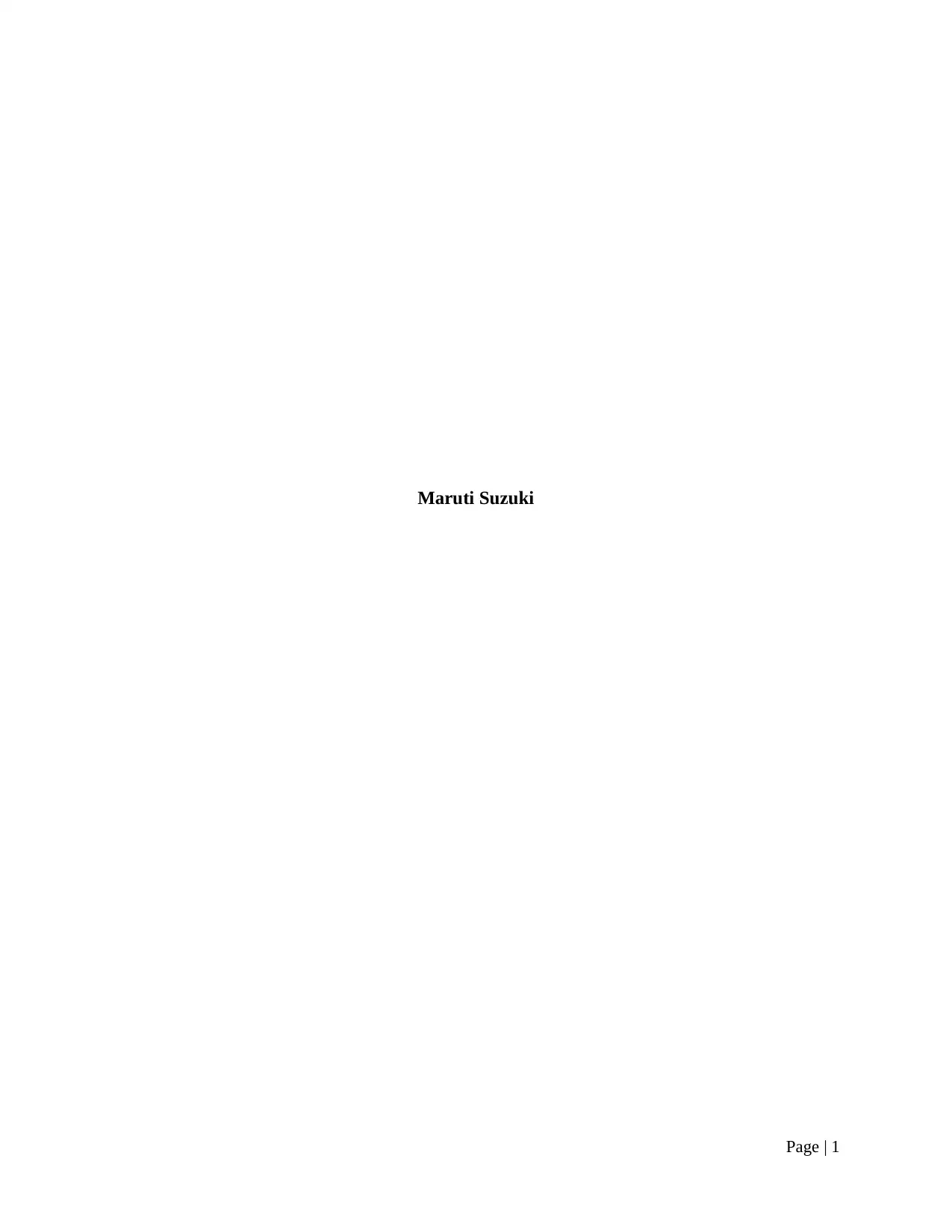
Maruti Suzuki
Page | 1
Page | 1
Paraphrase This Document
Need a fresh take? Get an instant paraphrase of this document with our AI Paraphraser

Executive Summary
This is a strategic report prepared for Maruti Suzuki, an automobile manufacturing company in
India. In this report, micro and macro environment analysis of Maruti Suzuki have been carried
out and found the presence of various opportunities and threats for this organization. Evaluation
of Maruti Suzuki’s resources identified the existence of distinctive capabilities for this
organization to help in gaining competitive advantage. Recommendations for international
growth of Maruti Suzuki are given to initially adopt exporting and then choose to have
subsidiary in Netherlands.
Page | 2
This is a strategic report prepared for Maruti Suzuki, an automobile manufacturing company in
India. In this report, micro and macro environment analysis of Maruti Suzuki have been carried
out and found the presence of various opportunities and threats for this organization. Evaluation
of Maruti Suzuki’s resources identified the existence of distinctive capabilities for this
organization to help in gaining competitive advantage. Recommendations for international
growth of Maruti Suzuki are given to initially adopt exporting and then choose to have
subsidiary in Netherlands.
Page | 2
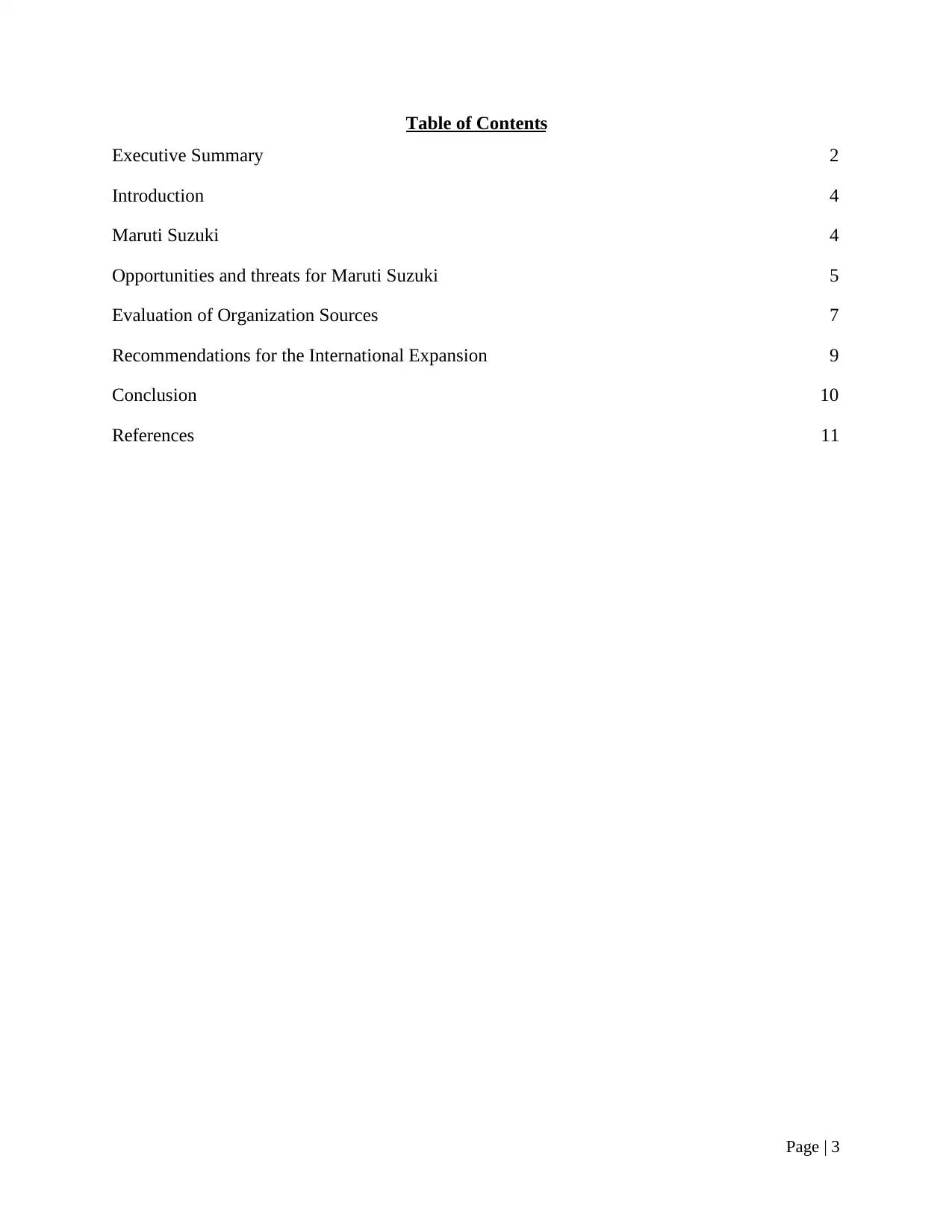
Table of Contents
Executive Summary 2
Introduction 4
Maruti Suzuki 4
Opportunities and threats for Maruti Suzuki 5
Evaluation of Organization Sources 7
Recommendations for the International Expansion 9
Conclusion 10
References 11
Page | 3
Executive Summary 2
Introduction 4
Maruti Suzuki 4
Opportunities and threats for Maruti Suzuki 5
Evaluation of Organization Sources 7
Recommendations for the International Expansion 9
Conclusion 10
References 11
Page | 3
⊘ This is a preview!⊘
Do you want full access?
Subscribe today to unlock all pages.

Trusted by 1+ million students worldwide
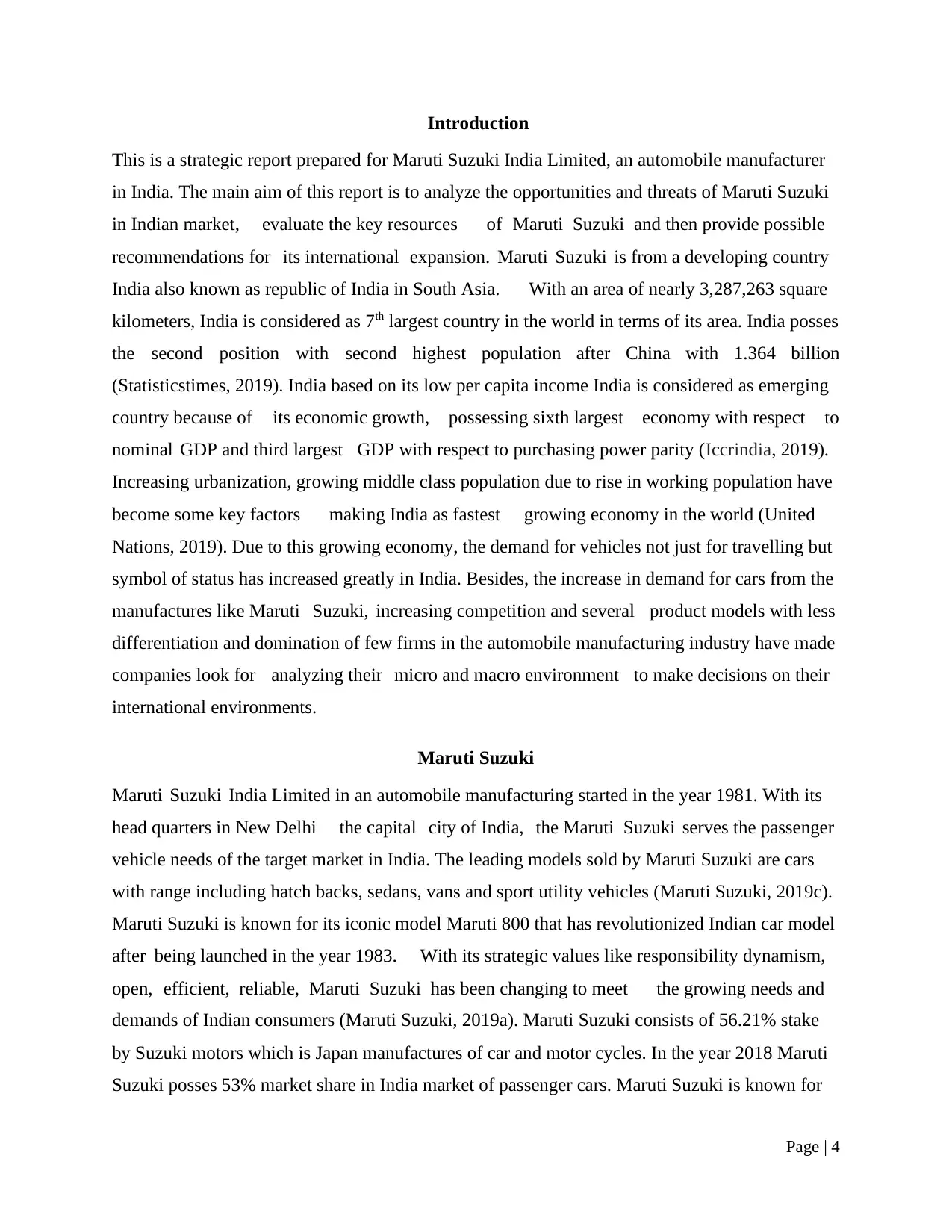
Introduction
This is a strategic report prepared for Maruti Suzuki India Limited, an automobile manufacturer
in India. The main aim of this report is to analyze the opportunities and threats of Maruti Suzuki
in Indian market, evaluate the key resources of Maruti Suzuki and then provide possible
recommendations for its international expansion. Maruti Suzuki is from a developing country
India also known as republic of India in South Asia. With an area of nearly 3,287,263 square
kilometers, India is considered as 7th largest country in the world in terms of its area. India posses
the second position with second highest population after China with 1.364 billion
(Statisticstimes, 2019). India based on its low per capita income India is considered as emerging
country because of its economic growth, possessing sixth largest economy with respect to
nominal GDP and third largest GDP with respect to purchasing power parity (Iccrindia, 2019).
Increasing urbanization, growing middle class population due to rise in working population have
become some key factors making India as fastest growing economy in the world (United
Nations, 2019). Due to this growing economy, the demand for vehicles not just for travelling but
symbol of status has increased greatly in India. Besides, the increase in demand for cars from the
manufactures like Maruti Suzuki, increasing competition and several product models with less
differentiation and domination of few firms in the automobile manufacturing industry have made
companies look for analyzing their micro and macro environment to make decisions on their
international environments.
Maruti Suzuki
Maruti Suzuki India Limited in an automobile manufacturing started in the year 1981. With its
head quarters in New Delhi the capital city of India, the Maruti Suzuki serves the passenger
vehicle needs of the target market in India. The leading models sold by Maruti Suzuki are cars
with range including hatch backs, sedans, vans and sport utility vehicles (Maruti Suzuki, 2019c).
Maruti Suzuki is known for its iconic model Maruti 800 that has revolutionized Indian car model
after being launched in the year 1983. With its strategic values like responsibility dynamism,
open, efficient, reliable, Maruti Suzuki has been changing to meet the growing needs and
demands of Indian consumers (Maruti Suzuki, 2019a). Maruti Suzuki consists of 56.21% stake
by Suzuki motors which is Japan manufactures of car and motor cycles. In the year 2018 Maruti
Suzuki posses 53% market share in India market of passenger cars. Maruti Suzuki is known for
Page | 4
This is a strategic report prepared for Maruti Suzuki India Limited, an automobile manufacturer
in India. The main aim of this report is to analyze the opportunities and threats of Maruti Suzuki
in Indian market, evaluate the key resources of Maruti Suzuki and then provide possible
recommendations for its international expansion. Maruti Suzuki is from a developing country
India also known as republic of India in South Asia. With an area of nearly 3,287,263 square
kilometers, India is considered as 7th largest country in the world in terms of its area. India posses
the second position with second highest population after China with 1.364 billion
(Statisticstimes, 2019). India based on its low per capita income India is considered as emerging
country because of its economic growth, possessing sixth largest economy with respect to
nominal GDP and third largest GDP with respect to purchasing power parity (Iccrindia, 2019).
Increasing urbanization, growing middle class population due to rise in working population have
become some key factors making India as fastest growing economy in the world (United
Nations, 2019). Due to this growing economy, the demand for vehicles not just for travelling but
symbol of status has increased greatly in India. Besides, the increase in demand for cars from the
manufactures like Maruti Suzuki, increasing competition and several product models with less
differentiation and domination of few firms in the automobile manufacturing industry have made
companies look for analyzing their micro and macro environment to make decisions on their
international environments.
Maruti Suzuki
Maruti Suzuki India Limited in an automobile manufacturing started in the year 1981. With its
head quarters in New Delhi the capital city of India, the Maruti Suzuki serves the passenger
vehicle needs of the target market in India. The leading models sold by Maruti Suzuki are cars
with range including hatch backs, sedans, vans and sport utility vehicles (Maruti Suzuki, 2019c).
Maruti Suzuki is known for its iconic model Maruti 800 that has revolutionized Indian car model
after being launched in the year 1983. With its strategic values like responsibility dynamism,
open, efficient, reliable, Maruti Suzuki has been changing to meet the growing needs and
demands of Indian consumers (Maruti Suzuki, 2019a). Maruti Suzuki consists of 56.21% stake
by Suzuki motors which is Japan manufactures of car and motor cycles. In the year 2018 Maruti
Suzuki posses 53% market share in India market of passenger cars. Maruti Suzuki is known for
Page | 4
Paraphrase This Document
Need a fresh take? Get an instant paraphrase of this document with our AI Paraphraser
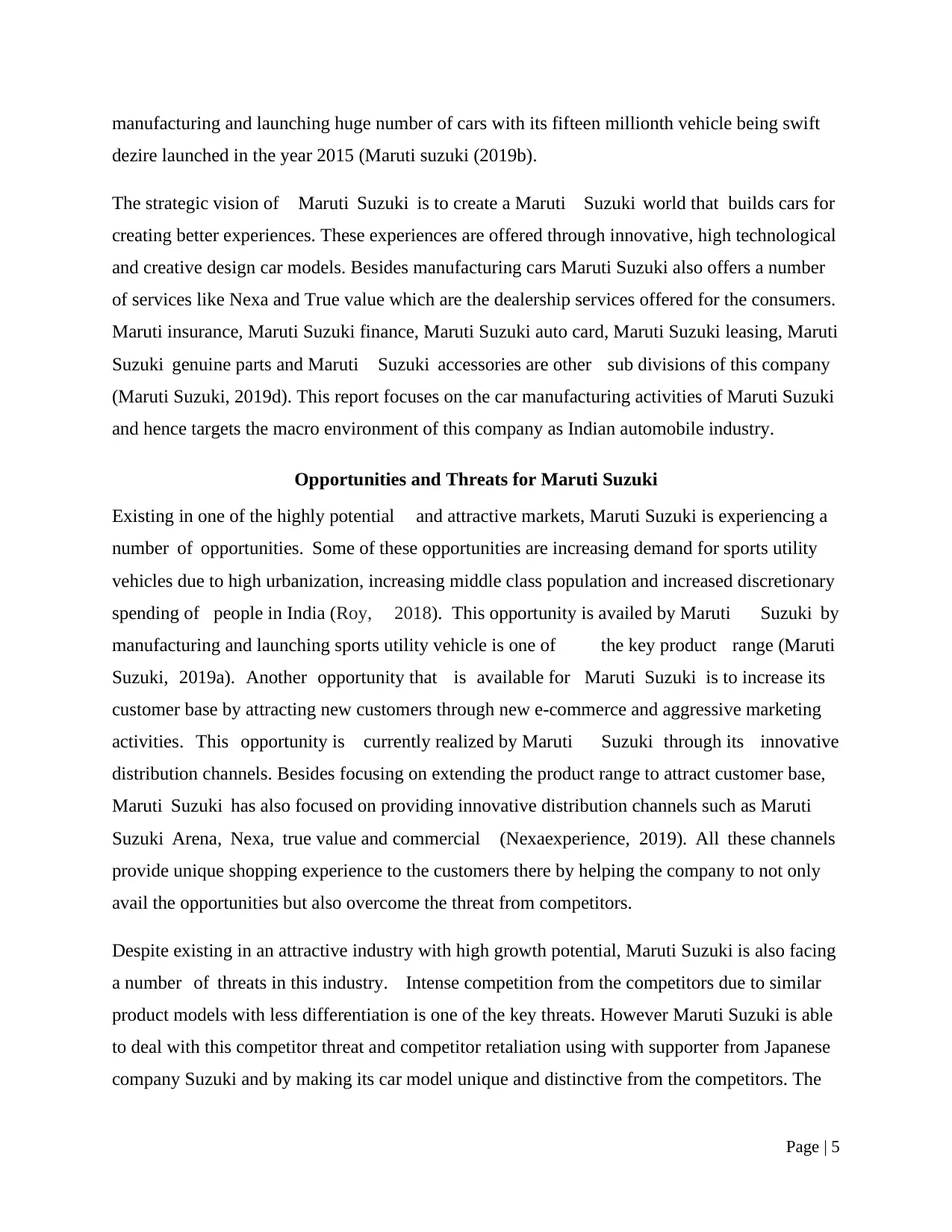
manufacturing and launching huge number of cars with its fifteen millionth vehicle being swift
dezire launched in the year 2015 (Maruti suzuki (2019b).
The strategic vision of Maruti Suzuki is to create a Maruti Suzuki world that builds cars for
creating better experiences. These experiences are offered through innovative, high technological
and creative design car models. Besides manufacturing cars Maruti Suzuki also offers a number
of services like Nexa and True value which are the dealership services offered for the consumers.
Maruti insurance, Maruti Suzuki finance, Maruti Suzuki auto card, Maruti Suzuki leasing, Maruti
Suzuki genuine parts and Maruti Suzuki accessories are other sub divisions of this company
(Maruti Suzuki, 2019d). This report focuses on the car manufacturing activities of Maruti Suzuki
and hence targets the macro environment of this company as Indian automobile industry.
Opportunities and Threats for Maruti Suzuki
Existing in one of the highly potential and attractive markets, Maruti Suzuki is experiencing a
number of opportunities. Some of these opportunities are increasing demand for sports utility
vehicles due to high urbanization, increasing middle class population and increased discretionary
spending of people in India (Roy, 2018). This opportunity is availed by Maruti Suzuki by
manufacturing and launching sports utility vehicle is one of the key product range (Maruti
Suzuki, 2019a). Another opportunity that is available for Maruti Suzuki is to increase its
customer base by attracting new customers through new e-commerce and aggressive marketing
activities. This opportunity is currently realized by Maruti Suzuki through its innovative
distribution channels. Besides focusing on extending the product range to attract customer base,
Maruti Suzuki has also focused on providing innovative distribution channels such as Maruti
Suzuki Arena, Nexa, true value and commercial (Nexaexperience, 2019). All these channels
provide unique shopping experience to the customers there by helping the company to not only
avail the opportunities but also overcome the threat from competitors.
Despite existing in an attractive industry with high growth potential, Maruti Suzuki is also facing
a number of threats in this industry. Intense competition from the competitors due to similar
product models with less differentiation is one of the key threats. However Maruti Suzuki is able
to deal with this competitor threat and competitor retaliation using with supporter from Japanese
company Suzuki and by making its car model unique and distinctive from the competitors. The
Page | 5
dezire launched in the year 2015 (Maruti suzuki (2019b).
The strategic vision of Maruti Suzuki is to create a Maruti Suzuki world that builds cars for
creating better experiences. These experiences are offered through innovative, high technological
and creative design car models. Besides manufacturing cars Maruti Suzuki also offers a number
of services like Nexa and True value which are the dealership services offered for the consumers.
Maruti insurance, Maruti Suzuki finance, Maruti Suzuki auto card, Maruti Suzuki leasing, Maruti
Suzuki genuine parts and Maruti Suzuki accessories are other sub divisions of this company
(Maruti Suzuki, 2019d). This report focuses on the car manufacturing activities of Maruti Suzuki
and hence targets the macro environment of this company as Indian automobile industry.
Opportunities and Threats for Maruti Suzuki
Existing in one of the highly potential and attractive markets, Maruti Suzuki is experiencing a
number of opportunities. Some of these opportunities are increasing demand for sports utility
vehicles due to high urbanization, increasing middle class population and increased discretionary
spending of people in India (Roy, 2018). This opportunity is availed by Maruti Suzuki by
manufacturing and launching sports utility vehicle is one of the key product range (Maruti
Suzuki, 2019a). Another opportunity that is available for Maruti Suzuki is to increase its
customer base by attracting new customers through new e-commerce and aggressive marketing
activities. This opportunity is currently realized by Maruti Suzuki through its innovative
distribution channels. Besides focusing on extending the product range to attract customer base,
Maruti Suzuki has also focused on providing innovative distribution channels such as Maruti
Suzuki Arena, Nexa, true value and commercial (Nexaexperience, 2019). All these channels
provide unique shopping experience to the customers there by helping the company to not only
avail the opportunities but also overcome the threat from competitors.
Despite existing in an attractive industry with high growth potential, Maruti Suzuki is also facing
a number of threats in this industry. Intense competition from the competitors due to similar
product models with less differentiation is one of the key threats. However Maruti Suzuki is able
to deal with this competitor threat and competitor retaliation using with supporter from Japanese
company Suzuki and by making its car model unique and distinctive from the competitors. The
Page | 5
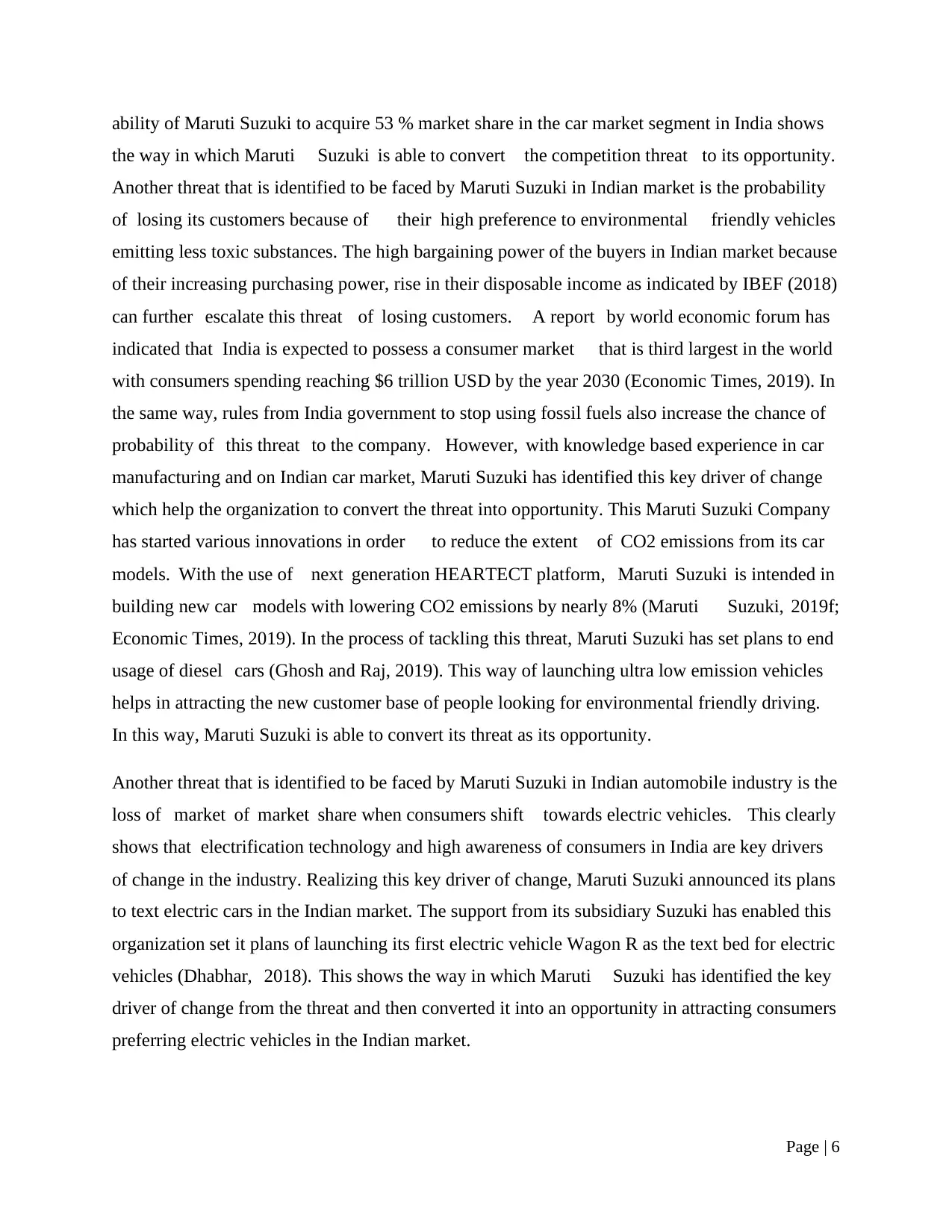
ability of Maruti Suzuki to acquire 53 % market share in the car market segment in India shows
the way in which Maruti Suzuki is able to convert the competition threat to its opportunity.
Another threat that is identified to be faced by Maruti Suzuki in Indian market is the probability
of losing its customers because of their high preference to environmental friendly vehicles
emitting less toxic substances. The high bargaining power of the buyers in Indian market because
of their increasing purchasing power, rise in their disposable income as indicated by IBEF (2018)
can further escalate this threat of losing customers. A report by world economic forum has
indicated that India is expected to possess a consumer market that is third largest in the world
with consumers spending reaching $6 trillion USD by the year 2030 (Economic Times, 2019). In
the same way, rules from India government to stop using fossil fuels also increase the chance of
probability of this threat to the company. However, with knowledge based experience in car
manufacturing and on Indian car market, Maruti Suzuki has identified this key driver of change
which help the organization to convert the threat into opportunity. This Maruti Suzuki Company
has started various innovations in order to reduce the extent of CO2 emissions from its car
models. With the use of next generation HEARTECT platform, Maruti Suzuki is intended in
building new car models with lowering CO2 emissions by nearly 8% (Maruti Suzuki, 2019f;
Economic Times, 2019). In the process of tackling this threat, Maruti Suzuki has set plans to end
usage of diesel cars (Ghosh and Raj, 2019). This way of launching ultra low emission vehicles
helps in attracting the new customer base of people looking for environmental friendly driving.
In this way, Maruti Suzuki is able to convert its threat as its opportunity.
Another threat that is identified to be faced by Maruti Suzuki in Indian automobile industry is the
loss of market of market share when consumers shift towards electric vehicles. This clearly
shows that electrification technology and high awareness of consumers in India are key drivers
of change in the industry. Realizing this key driver of change, Maruti Suzuki announced its plans
to text electric cars in the Indian market. The support from its subsidiary Suzuki has enabled this
organization set it plans of launching its first electric vehicle Wagon R as the text bed for electric
vehicles (Dhabhar, 2018). This shows the way in which Maruti Suzuki has identified the key
driver of change from the threat and then converted it into an opportunity in attracting consumers
preferring electric vehicles in the Indian market.
Page | 6
the way in which Maruti Suzuki is able to convert the competition threat to its opportunity.
Another threat that is identified to be faced by Maruti Suzuki in Indian market is the probability
of losing its customers because of their high preference to environmental friendly vehicles
emitting less toxic substances. The high bargaining power of the buyers in Indian market because
of their increasing purchasing power, rise in their disposable income as indicated by IBEF (2018)
can further escalate this threat of losing customers. A report by world economic forum has
indicated that India is expected to possess a consumer market that is third largest in the world
with consumers spending reaching $6 trillion USD by the year 2030 (Economic Times, 2019). In
the same way, rules from India government to stop using fossil fuels also increase the chance of
probability of this threat to the company. However, with knowledge based experience in car
manufacturing and on Indian car market, Maruti Suzuki has identified this key driver of change
which help the organization to convert the threat into opportunity. This Maruti Suzuki Company
has started various innovations in order to reduce the extent of CO2 emissions from its car
models. With the use of next generation HEARTECT platform, Maruti Suzuki is intended in
building new car models with lowering CO2 emissions by nearly 8% (Maruti Suzuki, 2019f;
Economic Times, 2019). In the process of tackling this threat, Maruti Suzuki has set plans to end
usage of diesel cars (Ghosh and Raj, 2019). This way of launching ultra low emission vehicles
helps in attracting the new customer base of people looking for environmental friendly driving.
In this way, Maruti Suzuki is able to convert its threat as its opportunity.
Another threat that is identified to be faced by Maruti Suzuki in Indian automobile industry is the
loss of market of market share when consumers shift towards electric vehicles. This clearly
shows that electrification technology and high awareness of consumers in India are key drivers
of change in the industry. Realizing this key driver of change, Maruti Suzuki announced its plans
to text electric cars in the Indian market. The support from its subsidiary Suzuki has enabled this
organization set it plans of launching its first electric vehicle Wagon R as the text bed for electric
vehicles (Dhabhar, 2018). This shows the way in which Maruti Suzuki has identified the key
driver of change from the threat and then converted it into an opportunity in attracting consumers
preferring electric vehicles in the Indian market.
Page | 6
⊘ This is a preview!⊘
Do you want full access?
Subscribe today to unlock all pages.

Trusted by 1+ million students worldwide
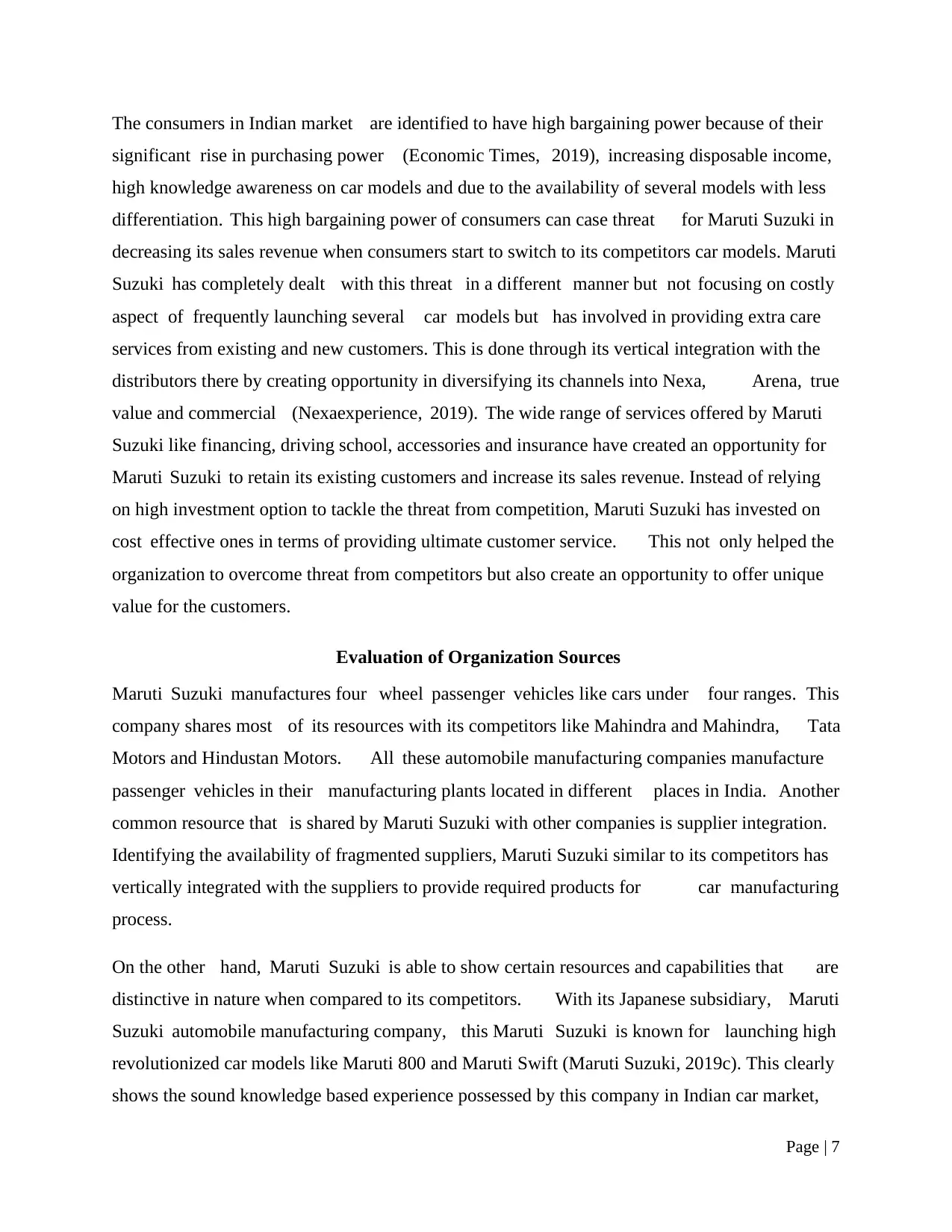
The consumers in Indian market are identified to have high bargaining power because of their
significant rise in purchasing power (Economic Times, 2019), increasing disposable income,
high knowledge awareness on car models and due to the availability of several models with less
differentiation. This high bargaining power of consumers can case threat for Maruti Suzuki in
decreasing its sales revenue when consumers start to switch to its competitors car models. Maruti
Suzuki has completely dealt with this threat in a different manner but not focusing on costly
aspect of frequently launching several car models but has involved in providing extra care
services from existing and new customers. This is done through its vertical integration with the
distributors there by creating opportunity in diversifying its channels into Nexa, Arena, true
value and commercial (Nexaexperience, 2019). The wide range of services offered by Maruti
Suzuki like financing, driving school, accessories and insurance have created an opportunity for
Maruti Suzuki to retain its existing customers and increase its sales revenue. Instead of relying
on high investment option to tackle the threat from competition, Maruti Suzuki has invested on
cost effective ones in terms of providing ultimate customer service. This not only helped the
organization to overcome threat from competitors but also create an opportunity to offer unique
value for the customers.
Evaluation of Organization Sources
Maruti Suzuki manufactures four wheel passenger vehicles like cars under four ranges. This
company shares most of its resources with its competitors like Mahindra and Mahindra, Tata
Motors and Hindustan Motors. All these automobile manufacturing companies manufacture
passenger vehicles in their manufacturing plants located in different places in India. Another
common resource that is shared by Maruti Suzuki with other companies is supplier integration.
Identifying the availability of fragmented suppliers, Maruti Suzuki similar to its competitors has
vertically integrated with the suppliers to provide required products for car manufacturing
process.
On the other hand, Maruti Suzuki is able to show certain resources and capabilities that are
distinctive in nature when compared to its competitors. With its Japanese subsidiary, Maruti
Suzuki automobile manufacturing company, this Maruti Suzuki is known for launching high
revolutionized car models like Maruti 800 and Maruti Swift (Maruti Suzuki, 2019c). This clearly
shows the sound knowledge based experience possessed by this company in Indian car market,
Page | 7
significant rise in purchasing power (Economic Times, 2019), increasing disposable income,
high knowledge awareness on car models and due to the availability of several models with less
differentiation. This high bargaining power of consumers can case threat for Maruti Suzuki in
decreasing its sales revenue when consumers start to switch to its competitors car models. Maruti
Suzuki has completely dealt with this threat in a different manner but not focusing on costly
aspect of frequently launching several car models but has involved in providing extra care
services from existing and new customers. This is done through its vertical integration with the
distributors there by creating opportunity in diversifying its channels into Nexa, Arena, true
value and commercial (Nexaexperience, 2019). The wide range of services offered by Maruti
Suzuki like financing, driving school, accessories and insurance have created an opportunity for
Maruti Suzuki to retain its existing customers and increase its sales revenue. Instead of relying
on high investment option to tackle the threat from competition, Maruti Suzuki has invested on
cost effective ones in terms of providing ultimate customer service. This not only helped the
organization to overcome threat from competitors but also create an opportunity to offer unique
value for the customers.
Evaluation of Organization Sources
Maruti Suzuki manufactures four wheel passenger vehicles like cars under four ranges. This
company shares most of its resources with its competitors like Mahindra and Mahindra, Tata
Motors and Hindustan Motors. All these automobile manufacturing companies manufacture
passenger vehicles in their manufacturing plants located in different places in India. Another
common resource that is shared by Maruti Suzuki with other companies is supplier integration.
Identifying the availability of fragmented suppliers, Maruti Suzuki similar to its competitors has
vertically integrated with the suppliers to provide required products for car manufacturing
process.
On the other hand, Maruti Suzuki is able to show certain resources and capabilities that are
distinctive in nature when compared to its competitors. With its Japanese subsidiary, Maruti
Suzuki automobile manufacturing company, this Maruti Suzuki is known for launching high
revolutionized car models like Maruti 800 and Maruti Swift (Maruti Suzuki, 2019c). This clearly
shows the sound knowledge based experience possessed by this company in Indian car market,
Page | 7
Paraphrase This Document
Need a fresh take? Get an instant paraphrase of this document with our AI Paraphraser
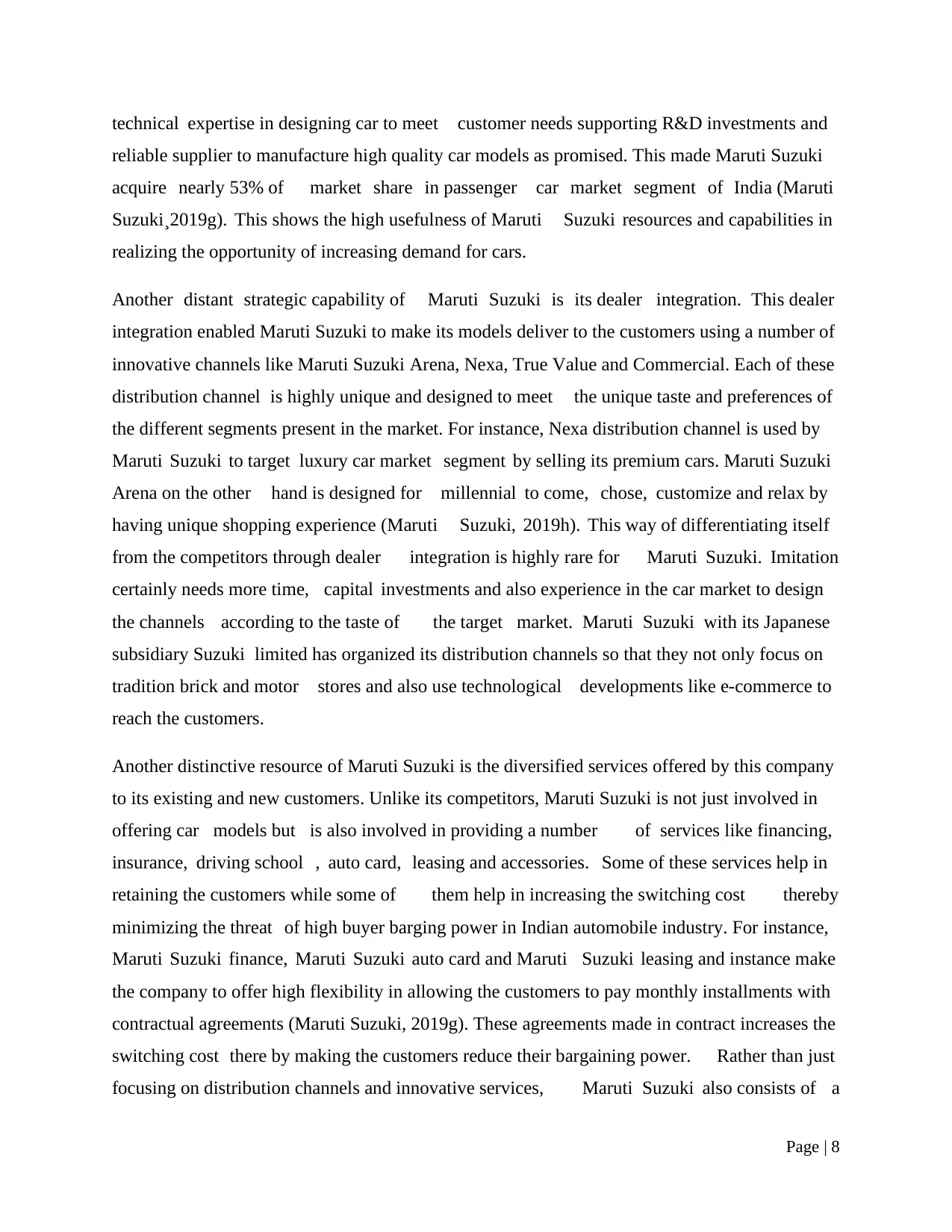
technical expertise in designing car to meet customer needs supporting R&D investments and
reliable supplier to manufacture high quality car models as promised. This made Maruti Suzuki
acquire nearly 53% of market share in passenger car market segment of India (Maruti
Suzuki¸2019g). This shows the high usefulness of Maruti Suzuki resources and capabilities in
realizing the opportunity of increasing demand for cars.
Another distant strategic capability of Maruti Suzuki is its dealer integration. This dealer
integration enabled Maruti Suzuki to make its models deliver to the customers using a number of
innovative channels like Maruti Suzuki Arena, Nexa, True Value and Commercial. Each of these
distribution channel is highly unique and designed to meet the unique taste and preferences of
the different segments present in the market. For instance, Nexa distribution channel is used by
Maruti Suzuki to target luxury car market segment by selling its premium cars. Maruti Suzuki
Arena on the other hand is designed for millennial to come, chose, customize and relax by
having unique shopping experience (Maruti Suzuki, 2019h). This way of differentiating itself
from the competitors through dealer integration is highly rare for Maruti Suzuki. Imitation
certainly needs more time, capital investments and also experience in the car market to design
the channels according to the taste of the target market. Maruti Suzuki with its Japanese
subsidiary Suzuki limited has organized its distribution channels so that they not only focus on
tradition brick and motor stores and also use technological developments like e-commerce to
reach the customers.
Another distinctive resource of Maruti Suzuki is the diversified services offered by this company
to its existing and new customers. Unlike its competitors, Maruti Suzuki is not just involved in
offering car models but is also involved in providing a number of services like financing,
insurance, driving school , auto card, leasing and accessories. Some of these services help in
retaining the customers while some of them help in increasing the switching cost thereby
minimizing the threat of high buyer barging power in Indian automobile industry. For instance,
Maruti Suzuki finance, Maruti Suzuki auto card and Maruti Suzuki leasing and instance make
the company to offer high flexibility in allowing the customers to pay monthly installments with
contractual agreements (Maruti Suzuki, 2019g). These agreements made in contract increases the
switching cost there by making the customers reduce their bargaining power. Rather than just
focusing on distribution channels and innovative services, Maruti Suzuki also consists of a
Page | 8
reliable supplier to manufacture high quality car models as promised. This made Maruti Suzuki
acquire nearly 53% of market share in passenger car market segment of India (Maruti
Suzuki¸2019g). This shows the high usefulness of Maruti Suzuki resources and capabilities in
realizing the opportunity of increasing demand for cars.
Another distant strategic capability of Maruti Suzuki is its dealer integration. This dealer
integration enabled Maruti Suzuki to make its models deliver to the customers using a number of
innovative channels like Maruti Suzuki Arena, Nexa, True Value and Commercial. Each of these
distribution channel is highly unique and designed to meet the unique taste and preferences of
the different segments present in the market. For instance, Nexa distribution channel is used by
Maruti Suzuki to target luxury car market segment by selling its premium cars. Maruti Suzuki
Arena on the other hand is designed for millennial to come, chose, customize and relax by
having unique shopping experience (Maruti Suzuki, 2019h). This way of differentiating itself
from the competitors through dealer integration is highly rare for Maruti Suzuki. Imitation
certainly needs more time, capital investments and also experience in the car market to design
the channels according to the taste of the target market. Maruti Suzuki with its Japanese
subsidiary Suzuki limited has organized its distribution channels so that they not only focus on
tradition brick and motor stores and also use technological developments like e-commerce to
reach the customers.
Another distinctive resource of Maruti Suzuki is the diversified services offered by this company
to its existing and new customers. Unlike its competitors, Maruti Suzuki is not just involved in
offering car models but is also involved in providing a number of services like financing,
insurance, driving school , auto card, leasing and accessories. Some of these services help in
retaining the customers while some of them help in increasing the switching cost thereby
minimizing the threat of high buyer barging power in Indian automobile industry. For instance,
Maruti Suzuki finance, Maruti Suzuki auto card and Maruti Suzuki leasing and instance make
the company to offer high flexibility in allowing the customers to pay monthly installments with
contractual agreements (Maruti Suzuki, 2019g). These agreements made in contract increases the
switching cost there by making the customers reduce their bargaining power. Rather than just
focusing on distribution channels and innovative services, Maruti Suzuki also consists of a
Page | 8
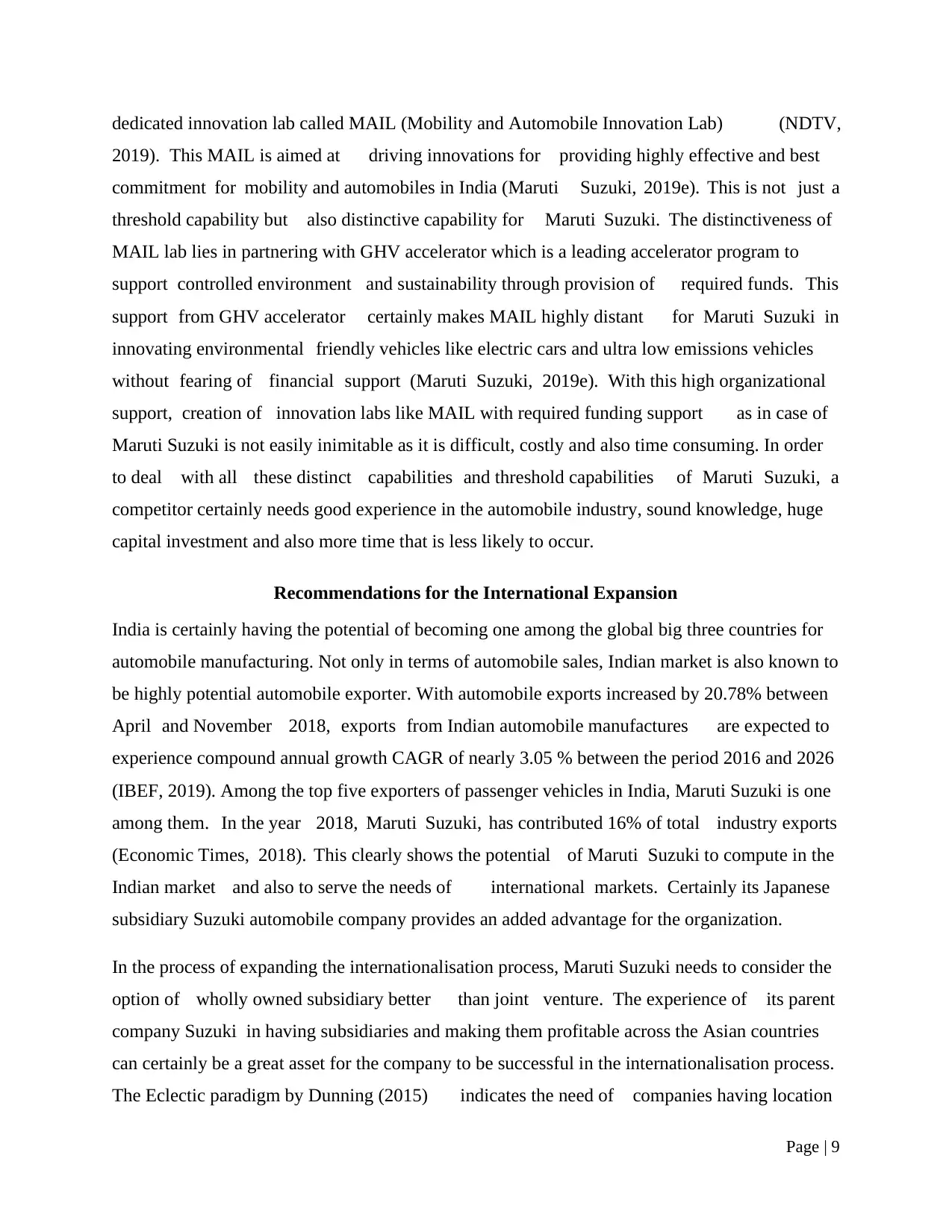
dedicated innovation lab called MAIL (Mobility and Automobile Innovation Lab) (NDTV,
2019). This MAIL is aimed at driving innovations for providing highly effective and best
commitment for mobility and automobiles in India (Maruti Suzuki, 2019e). This is not just a
threshold capability but also distinctive capability for Maruti Suzuki. The distinctiveness of
MAIL lab lies in partnering with GHV accelerator which is a leading accelerator program to
support controlled environment and sustainability through provision of required funds. This
support from GHV accelerator certainly makes MAIL highly distant for Maruti Suzuki in
innovating environmental friendly vehicles like electric cars and ultra low emissions vehicles
without fearing of financial support (Maruti Suzuki, 2019e). With this high organizational
support, creation of innovation labs like MAIL with required funding support as in case of
Maruti Suzuki is not easily inimitable as it is difficult, costly and also time consuming. In order
to deal with all these distinct capabilities and threshold capabilities of Maruti Suzuki, a
competitor certainly needs good experience in the automobile industry, sound knowledge, huge
capital investment and also more time that is less likely to occur.
Recommendations for the International Expansion
India is certainly having the potential of becoming one among the global big three countries for
automobile manufacturing. Not only in terms of automobile sales, Indian market is also known to
be highly potential automobile exporter. With automobile exports increased by 20.78% between
April and November 2018, exports from Indian automobile manufactures are expected to
experience compound annual growth CAGR of nearly 3.05 % between the period 2016 and 2026
(IBEF, 2019). Among the top five exporters of passenger vehicles in India, Maruti Suzuki is one
among them. In the year 2018, Maruti Suzuki, has contributed 16% of total industry exports
(Economic Times, 2018). This clearly shows the potential of Maruti Suzuki to compute in the
Indian market and also to serve the needs of international markets. Certainly its Japanese
subsidiary Suzuki automobile company provides an added advantage for the organization.
In the process of expanding the internationalisation process, Maruti Suzuki needs to consider the
option of wholly owned subsidiary better than joint venture. The experience of its parent
company Suzuki in having subsidiaries and making them profitable across the Asian countries
can certainly be a great asset for the company to be successful in the internationalisation process.
The Eclectic paradigm by Dunning (2015) indicates the need of companies having location
Page | 9
2019). This MAIL is aimed at driving innovations for providing highly effective and best
commitment for mobility and automobiles in India (Maruti Suzuki, 2019e). This is not just a
threshold capability but also distinctive capability for Maruti Suzuki. The distinctiveness of
MAIL lab lies in partnering with GHV accelerator which is a leading accelerator program to
support controlled environment and sustainability through provision of required funds. This
support from GHV accelerator certainly makes MAIL highly distant for Maruti Suzuki in
innovating environmental friendly vehicles like electric cars and ultra low emissions vehicles
without fearing of financial support (Maruti Suzuki, 2019e). With this high organizational
support, creation of innovation labs like MAIL with required funding support as in case of
Maruti Suzuki is not easily inimitable as it is difficult, costly and also time consuming. In order
to deal with all these distinct capabilities and threshold capabilities of Maruti Suzuki, a
competitor certainly needs good experience in the automobile industry, sound knowledge, huge
capital investment and also more time that is less likely to occur.
Recommendations for the International Expansion
India is certainly having the potential of becoming one among the global big three countries for
automobile manufacturing. Not only in terms of automobile sales, Indian market is also known to
be highly potential automobile exporter. With automobile exports increased by 20.78% between
April and November 2018, exports from Indian automobile manufactures are expected to
experience compound annual growth CAGR of nearly 3.05 % between the period 2016 and 2026
(IBEF, 2019). Among the top five exporters of passenger vehicles in India, Maruti Suzuki is one
among them. In the year 2018, Maruti Suzuki, has contributed 16% of total industry exports
(Economic Times, 2018). This clearly shows the potential of Maruti Suzuki to compute in the
Indian market and also to serve the needs of international markets. Certainly its Japanese
subsidiary Suzuki automobile company provides an added advantage for the organization.
In the process of expanding the internationalisation process, Maruti Suzuki needs to consider the
option of wholly owned subsidiary better than joint venture. The experience of its parent
company Suzuki in having subsidiaries and making them profitable across the Asian countries
can certainly be a great asset for the company to be successful in the internationalisation process.
The Eclectic paradigm by Dunning (2015) indicates the need of companies having location
Page | 9
⊘ This is a preview!⊘
Do you want full access?
Subscribe today to unlock all pages.

Trusted by 1+ million students worldwide
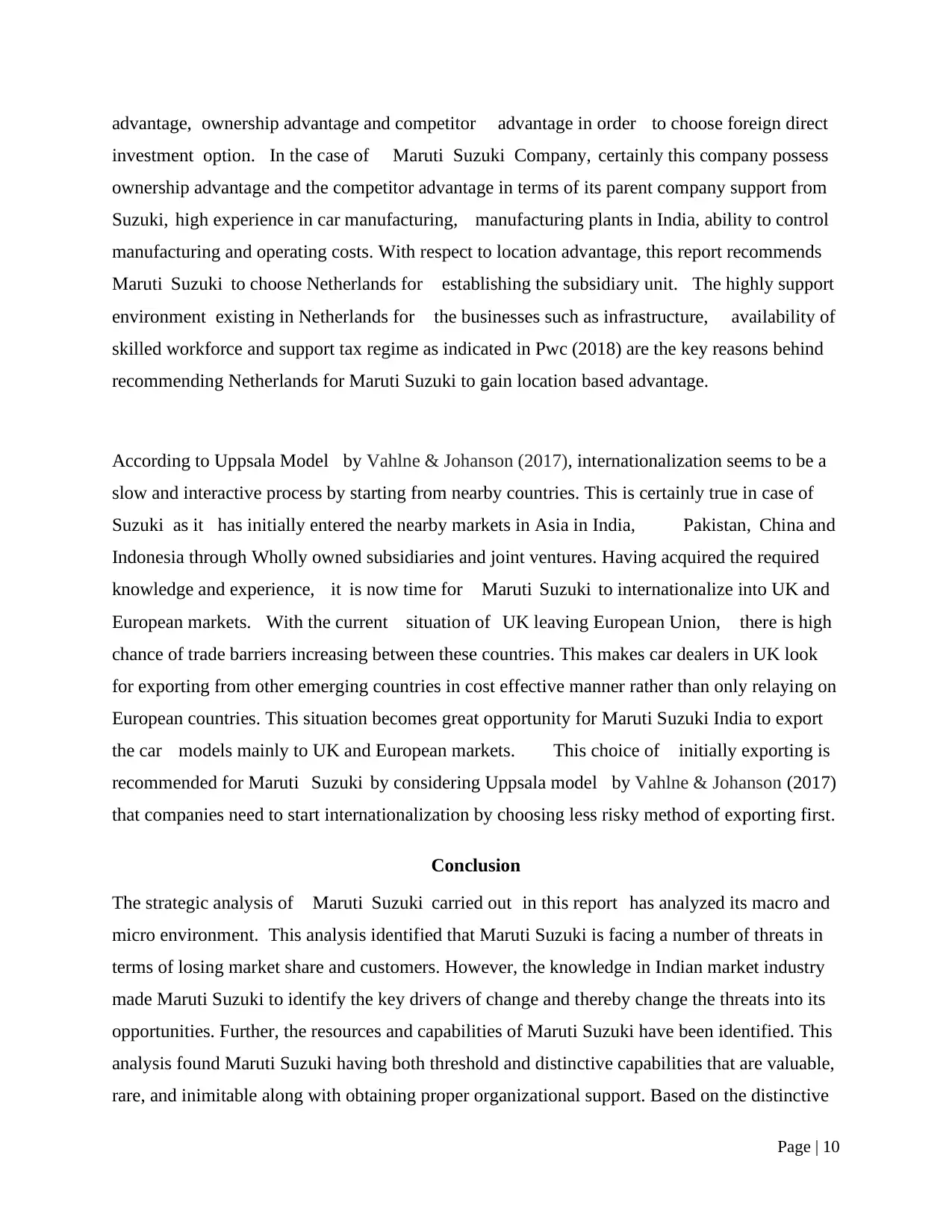
advantage, ownership advantage and competitor advantage in order to choose foreign direct
investment option. In the case of Maruti Suzuki Company, certainly this company possess
ownership advantage and the competitor advantage in terms of its parent company support from
Suzuki, high experience in car manufacturing, manufacturing plants in India, ability to control
manufacturing and operating costs. With respect to location advantage, this report recommends
Maruti Suzuki to choose Netherlands for establishing the subsidiary unit. The highly support
environment existing in Netherlands for the businesses such as infrastructure, availability of
skilled workforce and support tax regime as indicated in Pwc (2018) are the key reasons behind
recommending Netherlands for Maruti Suzuki to gain location based advantage.
According to Uppsala Model by Vahlne & Johanson (2017), internationalization seems to be a
slow and interactive process by starting from nearby countries. This is certainly true in case of
Suzuki as it has initially entered the nearby markets in Asia in India, Pakistan, China and
Indonesia through Wholly owned subsidiaries and joint ventures. Having acquired the required
knowledge and experience, it is now time for Maruti Suzuki to internationalize into UK and
European markets. With the current situation of UK leaving European Union, there is high
chance of trade barriers increasing between these countries. This makes car dealers in UK look
for exporting from other emerging countries in cost effective manner rather than only relaying on
European countries. This situation becomes great opportunity for Maruti Suzuki India to export
the car models mainly to UK and European markets. This choice of initially exporting is
recommended for Maruti Suzuki by considering Uppsala model by Vahlne & Johanson (2017)
that companies need to start internationalization by choosing less risky method of exporting first.
Conclusion
The strategic analysis of Maruti Suzuki carried out in this report has analyzed its macro and
micro environment. This analysis identified that Maruti Suzuki is facing a number of threats in
terms of losing market share and customers. However, the knowledge in Indian market industry
made Maruti Suzuki to identify the key drivers of change and thereby change the threats into its
opportunities. Further, the resources and capabilities of Maruti Suzuki have been identified. This
analysis found Maruti Suzuki having both threshold and distinctive capabilities that are valuable,
rare, and inimitable along with obtaining proper organizational support. Based on the distinctive
Page | 10
investment option. In the case of Maruti Suzuki Company, certainly this company possess
ownership advantage and the competitor advantage in terms of its parent company support from
Suzuki, high experience in car manufacturing, manufacturing plants in India, ability to control
manufacturing and operating costs. With respect to location advantage, this report recommends
Maruti Suzuki to choose Netherlands for establishing the subsidiary unit. The highly support
environment existing in Netherlands for the businesses such as infrastructure, availability of
skilled workforce and support tax regime as indicated in Pwc (2018) are the key reasons behind
recommending Netherlands for Maruti Suzuki to gain location based advantage.
According to Uppsala Model by Vahlne & Johanson (2017), internationalization seems to be a
slow and interactive process by starting from nearby countries. This is certainly true in case of
Suzuki as it has initially entered the nearby markets in Asia in India, Pakistan, China and
Indonesia through Wholly owned subsidiaries and joint ventures. Having acquired the required
knowledge and experience, it is now time for Maruti Suzuki to internationalize into UK and
European markets. With the current situation of UK leaving European Union, there is high
chance of trade barriers increasing between these countries. This makes car dealers in UK look
for exporting from other emerging countries in cost effective manner rather than only relaying on
European countries. This situation becomes great opportunity for Maruti Suzuki India to export
the car models mainly to UK and European markets. This choice of initially exporting is
recommended for Maruti Suzuki by considering Uppsala model by Vahlne & Johanson (2017)
that companies need to start internationalization by choosing less risky method of exporting first.
Conclusion
The strategic analysis of Maruti Suzuki carried out in this report has analyzed its macro and
micro environment. This analysis identified that Maruti Suzuki is facing a number of threats in
terms of losing market share and customers. However, the knowledge in Indian market industry
made Maruti Suzuki to identify the key drivers of change and thereby change the threats into its
opportunities. Further, the resources and capabilities of Maruti Suzuki have been identified. This
analysis found Maruti Suzuki having both threshold and distinctive capabilities that are valuable,
rare, and inimitable along with obtaining proper organizational support. Based on the distinctive
Page | 10
Paraphrase This Document
Need a fresh take? Get an instant paraphrase of this document with our AI Paraphraser
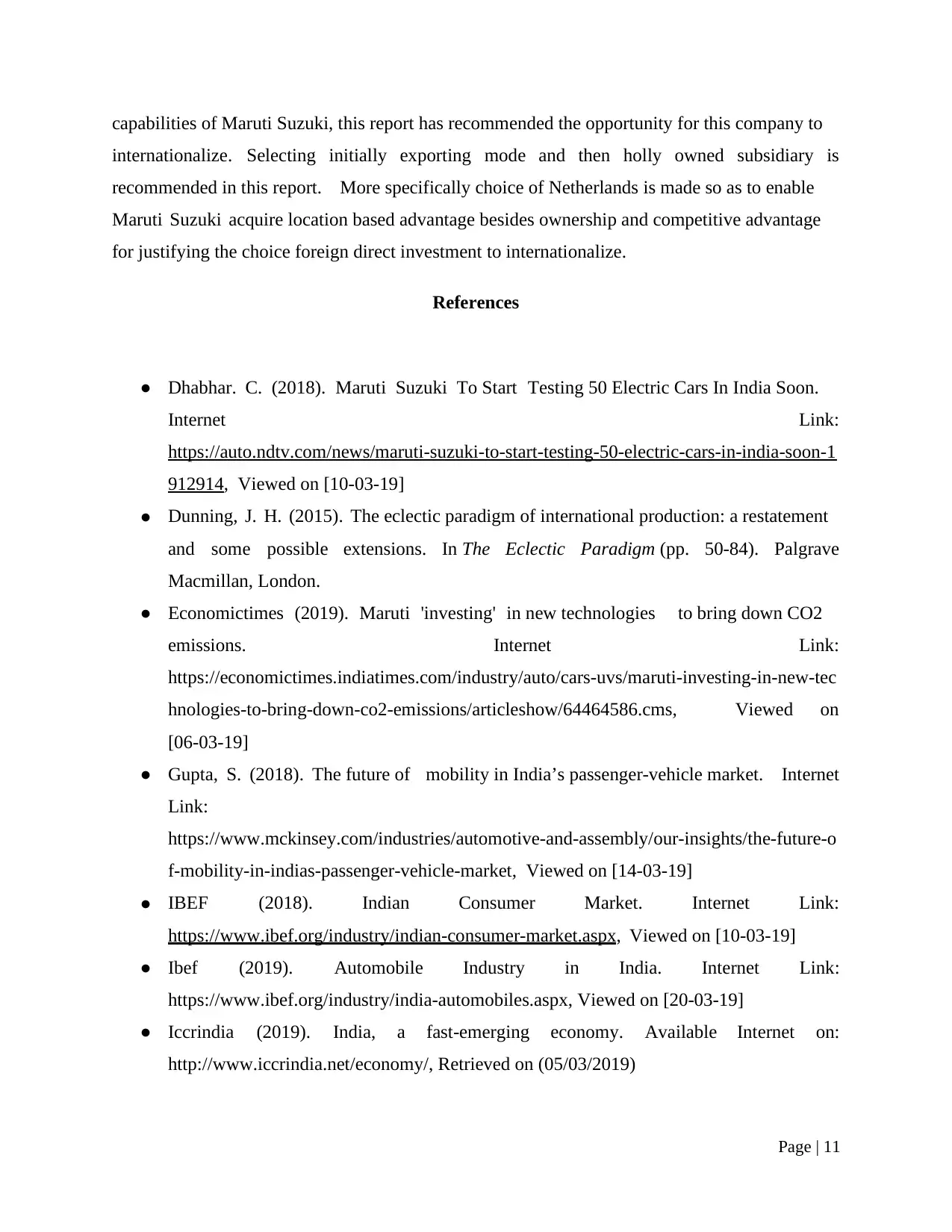
capabilities of Maruti Suzuki, this report has recommended the opportunity for this company to
internationalize. Selecting initially exporting mode and then holly owned subsidiary is
recommended in this report. More specifically choice of Netherlands is made so as to enable
Maruti Suzuki acquire location based advantage besides ownership and competitive advantage
for justifying the choice foreign direct investment to internationalize.
References
● Dhabhar. C. (2018). Maruti Suzuki To Start Testing 50 Electric Cars In India Soon.
Internet Link:
https://auto.ndtv.com/news/maruti-suzuki-to-start-testing-50-electric-cars-in-india-soon-1
912914, Viewed on [10-03-19]
● Dunning, J. H. (2015). The eclectic paradigm of international production: a restatement
and some possible extensions. In The Eclectic Paradigm (pp. 50-84). Palgrave
Macmillan, London.
● Economictimes (2019). Maruti 'investing' in new technologies to bring down CO2
emissions. Internet Link:
https://economictimes.indiatimes.com/industry/auto/cars-uvs/maruti-investing-in-new-tec
hnologies-to-bring-down-co2-emissions/articleshow/64464586.cms, Viewed on
[06-03-19]
● Gupta, S. (2018). The future of mobility in India’s passenger-vehicle market. Internet
Link:
https://www.mckinsey.com/industries/automotive-and-assembly/our-insights/the-future-o
f-mobility-in-indias-passenger-vehicle-market, Viewed on [14-03-19]
● IBEF (2018). Indian Consumer Market. Internet Link:
https://www.ibef.org/industry/indian-consumer-market.aspx, Viewed on [10-03-19]
● Ibef (2019). Automobile Industry in India. Internet Link:
https://www.ibef.org/industry/india-automobiles.aspx, Viewed on [20-03-19]
● Iccrindia (2019). India, a fast-emerging economy. Available Internet on:
http://www.iccrindia.net/economy/, Retrieved on (05/03/2019)
Page | 11
internationalize. Selecting initially exporting mode and then holly owned subsidiary is
recommended in this report. More specifically choice of Netherlands is made so as to enable
Maruti Suzuki acquire location based advantage besides ownership and competitive advantage
for justifying the choice foreign direct investment to internationalize.
References
● Dhabhar. C. (2018). Maruti Suzuki To Start Testing 50 Electric Cars In India Soon.
Internet Link:
https://auto.ndtv.com/news/maruti-suzuki-to-start-testing-50-electric-cars-in-india-soon-1
912914, Viewed on [10-03-19]
● Dunning, J. H. (2015). The eclectic paradigm of international production: a restatement
and some possible extensions. In The Eclectic Paradigm (pp. 50-84). Palgrave
Macmillan, London.
● Economictimes (2019). Maruti 'investing' in new technologies to bring down CO2
emissions. Internet Link:
https://economictimes.indiatimes.com/industry/auto/cars-uvs/maruti-investing-in-new-tec
hnologies-to-bring-down-co2-emissions/articleshow/64464586.cms, Viewed on
[06-03-19]
● Gupta, S. (2018). The future of mobility in India’s passenger-vehicle market. Internet
Link:
https://www.mckinsey.com/industries/automotive-and-assembly/our-insights/the-future-o
f-mobility-in-indias-passenger-vehicle-market, Viewed on [14-03-19]
● IBEF (2018). Indian Consumer Market. Internet Link:
https://www.ibef.org/industry/indian-consumer-market.aspx, Viewed on [10-03-19]
● Ibef (2019). Automobile Industry in India. Internet Link:
https://www.ibef.org/industry/india-automobiles.aspx, Viewed on [20-03-19]
● Iccrindia (2019). India, a fast-emerging economy. Available Internet on:
http://www.iccrindia.net/economy/, Retrieved on (05/03/2019)
Page | 11
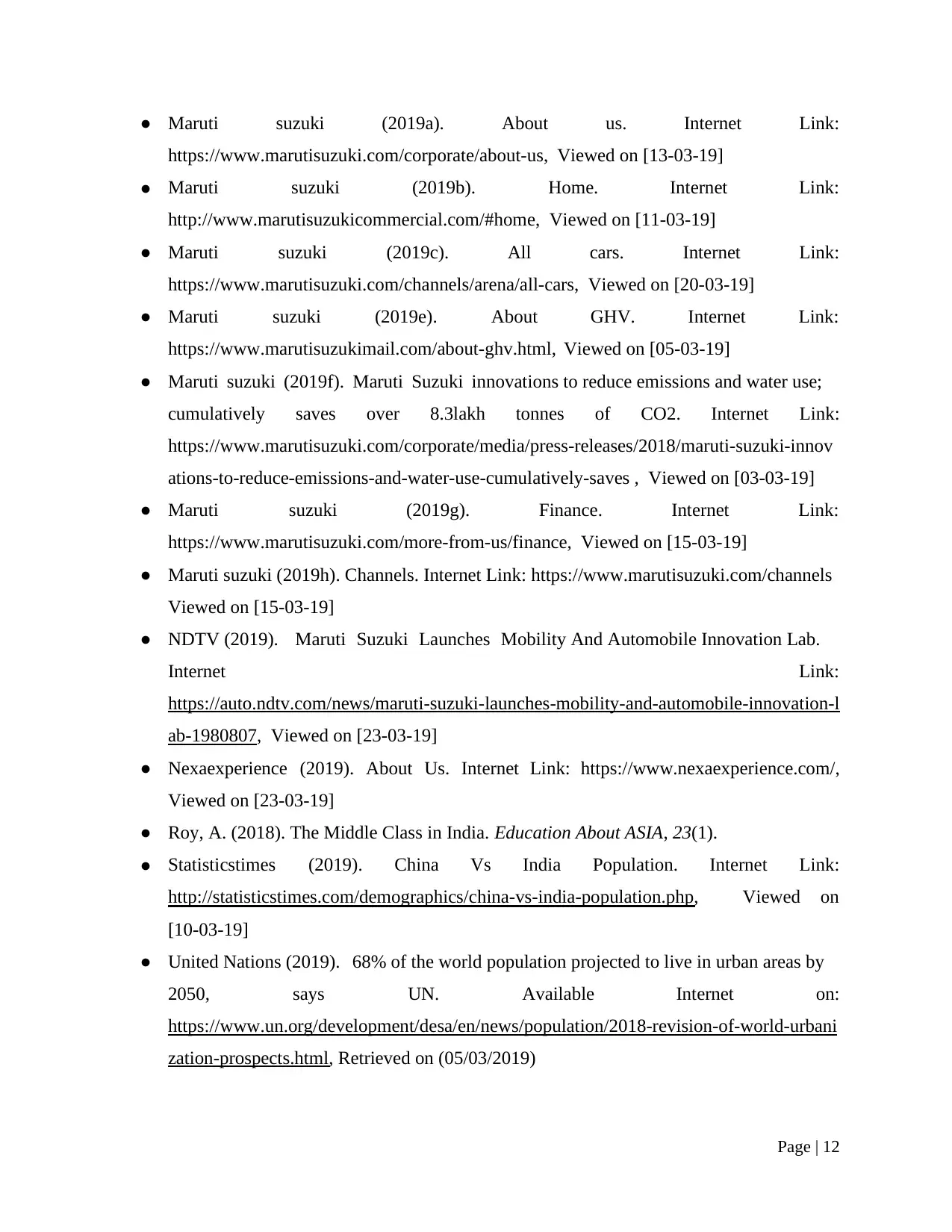
● Maruti suzuki (2019a). About us. Internet Link:
https://www.marutisuzuki.com/corporate/about-us, Viewed on [13-03-19]
● Maruti suzuki (2019b). Home. Internet Link:
http://www.marutisuzukicommercial.com/#home, Viewed on [11-03-19]
● Maruti suzuki (2019c). All cars. Internet Link:
https://www.marutisuzuki.com/channels/arena/all-cars, Viewed on [20-03-19]
● Maruti suzuki (2019e). About GHV. Internet Link:
https://www.marutisuzukimail.com/about-ghv.html, Viewed on [05-03-19]
● Maruti suzuki (2019f). Maruti Suzuki innovations to reduce emissions and water use;
cumulatively saves over 8.3lakh tonnes of CO2. Internet Link:
https://www.marutisuzuki.com/corporate/media/press-releases/2018/maruti-suzuki-innov
ations-to-reduce-emissions-and-water-use-cumulatively-saves , Viewed on [03-03-19]
● Maruti suzuki (2019g). Finance. Internet Link:
https://www.marutisuzuki.com/more-from-us/finance, Viewed on [15-03-19]
● Maruti suzuki (2019h). Channels. Internet Link: https://www.marutisuzuki.com/channels
Viewed on [15-03-19]
● NDTV (2019). Maruti Suzuki Launches Mobility And Automobile Innovation Lab.
Internet Link:
https://auto.ndtv.com/news/maruti-suzuki-launches-mobility-and-automobile-innovation-l
ab-1980807, Viewed on [23-03-19]
● Nexaexperience (2019). About Us. Internet Link: https://www.nexaexperience.com/,
Viewed on [23-03-19]
● Roy, A. (2018). The Middle Class in India. Education About ASIA, 23(1).
● Statisticstimes (2019). China Vs India Population. Internet Link:
http://statisticstimes.com/demographics/china-vs-india-population.php, Viewed on
[10-03-19]
● United Nations (2019). 68% of the world population projected to live in urban areas by
2050, says UN. Available Internet on:
https://www.un.org/development/desa/en/news/population/2018-revision-of-world-urbani
zation-prospects.html, Retrieved on (05/03/2019)
Page | 12
https://www.marutisuzuki.com/corporate/about-us, Viewed on [13-03-19]
● Maruti suzuki (2019b). Home. Internet Link:
http://www.marutisuzukicommercial.com/#home, Viewed on [11-03-19]
● Maruti suzuki (2019c). All cars. Internet Link:
https://www.marutisuzuki.com/channels/arena/all-cars, Viewed on [20-03-19]
● Maruti suzuki (2019e). About GHV. Internet Link:
https://www.marutisuzukimail.com/about-ghv.html, Viewed on [05-03-19]
● Maruti suzuki (2019f). Maruti Suzuki innovations to reduce emissions and water use;
cumulatively saves over 8.3lakh tonnes of CO2. Internet Link:
https://www.marutisuzuki.com/corporate/media/press-releases/2018/maruti-suzuki-innov
ations-to-reduce-emissions-and-water-use-cumulatively-saves , Viewed on [03-03-19]
● Maruti suzuki (2019g). Finance. Internet Link:
https://www.marutisuzuki.com/more-from-us/finance, Viewed on [15-03-19]
● Maruti suzuki (2019h). Channels. Internet Link: https://www.marutisuzuki.com/channels
Viewed on [15-03-19]
● NDTV (2019). Maruti Suzuki Launches Mobility And Automobile Innovation Lab.
Internet Link:
https://auto.ndtv.com/news/maruti-suzuki-launches-mobility-and-automobile-innovation-l
ab-1980807, Viewed on [23-03-19]
● Nexaexperience (2019). About Us. Internet Link: https://www.nexaexperience.com/,
Viewed on [23-03-19]
● Roy, A. (2018). The Middle Class in India. Education About ASIA, 23(1).
● Statisticstimes (2019). China Vs India Population. Internet Link:
http://statisticstimes.com/demographics/china-vs-india-population.php, Viewed on
[10-03-19]
● United Nations (2019). 68% of the world population projected to live in urban areas by
2050, says UN. Available Internet on:
https://www.un.org/development/desa/en/news/population/2018-revision-of-world-urbani
zation-prospects.html, Retrieved on (05/03/2019)
Page | 12
⊘ This is a preview!⊘
Do you want full access?
Subscribe today to unlock all pages.

Trusted by 1+ million students worldwide
1 out of 13
Related Documents
Your All-in-One AI-Powered Toolkit for Academic Success.
+13062052269
info@desklib.com
Available 24*7 on WhatsApp / Email
![[object Object]](/_next/static/media/star-bottom.7253800d.svg)
Unlock your academic potential
Copyright © 2020–2025 A2Z Services. All Rights Reserved. Developed and managed by ZUCOL.





